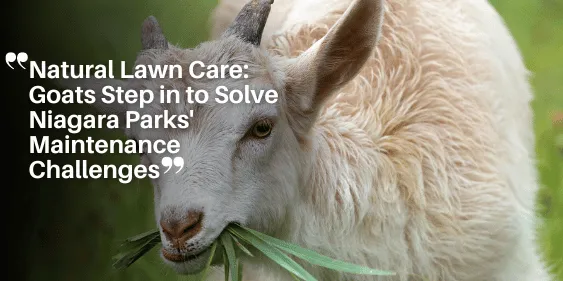The Challenge of Invasive Species in Fort Erie
In Fort Erie, Ontario, the serene landscapes of Gonder’s Flats faced a formidable threat from invasive phragmites, disrupting the delicate ecosystem nurtured by Niagara Parks since 2014.
These tall reeds, reaching up to five meters in height, had overrun the area, choking out native plant species crucial for biodiversity.
Traditional methods like using tractors were impractical due to the wetland terrain, and chemical solutions posed risks to the environment.
The introduction of goats as natural grazers emerged as a promising solution, leveraging their ability to navigate muddy terrains and their voracious appetite for phragmites, which ensures a sustainable, environmentally friendly approach to managing invasive species in the region.
Introducing the Green Grazers: A Natural Solution
To combat this ecological menace, Niagara Parks turned to a natural and innovative approach: goats.
Led by environmental planning technician Victoria Kalenuik, the initiative aimed to utilize goats for their natural ability to devour vegetation without causing harm to the ecosystem.
Inspired by Ontario Power Generation’s successful use of sheep for vegetation control, Niagara Parks launched a one-week pilot project with 40 goats sourced from a local farm.
The goats, dubbed the Green Grazers, were deployed daily to Gonder’s Flats, where they voraciously consumed phragmites, offering a sustainable and environmentally friendly solution to manage invasive species in the region.
This initiative not only showcases the efficacy of nature-based solutions but also underscores the importance of adaptive strategies in modern environmental stewardship.
The Role of Goats in Environmental Conservation
Each day of the pilot project saw the Green Grazers enthusiastically munching through the phragmites at Gonder’s Flats.
This method not only provided an effective means of vegetation control but also demonstrated the goats’ agility in navigating the muddy terrain of the wetlands.
Unlike mechanical methods, goats posed no risk of damaging the delicate ecosystem, making them an environmentally friendly choice.
Their presence also sparked interest among visitors, who observed firsthand the goats’ natural behavior contributing to the conservation efforts of Niagara Parks.
This initiative highlights the role of goats not just as effective grazers but as ambassadors for sustainable environmental practices in modern conservation.
Environmental and Practical Benefits
One of the key advantages of employing goats lies in their digestive process.
Phragmite seeds consumed by goats are rendered inert, preventing further spread of the invasive plant.
This biological control mechanism ensures that the problem is tackled at its source without inadvertently exacerbating it.
Moreover, the goats’ presence serves as a sustainable long-term solution, potentially reducing the need for costly and environmentally harmful chemical treatments.
Their natural grazing behavior also helps maintain biodiversity by allowing native plants to thrive, thereby restoring ecological balance to Gonder’s Flats and promoting a healthier ecosystem overall.
Learning from Successful Models
Niagara Parks drew inspiration from Ontario Power Generation’s use of sheep, which effectively controlled vegetation at the Nanticoke Solar facility.
This environmentally friendly approach, implemented since 2019, underscored the viability of using livestock for vegetation management in sensitive environmental areas.
By adapting this strategy to the unique challenges posed by phragmites at Gonder’s Flats, Niagara Parks aims to establish a precedent for sustainable land management practices.
This initiative not only addresses immediate ecological threats but also sets a model for other conservation efforts seeking effective and eco-friendly solutions to invasive species management.
The Path Forward: Long-term Sustainability
The success of the one-week pilot project has paved the way for ongoing efforts to integrate goats into Niagara Parks’ ecosystem management strategy.
As discussions continue, stakeholders are optimistic about expanding the use of goats to other areas affected by invasive species.
This proactive approach not only addresses immediate environmental challenges but also aligns with broader goals of sustainability and biodiversity conservation.
Conclusion: A Natural Approach to Environmental Stewardship
In conclusion, Niagara Parks’ initiative exemplifies the power of innovative thinking in environmental stewardship.
By harnessing the natural grazing instincts of goats, the park is not only preserving its landscapes but also fostering a model of sustainable land management for other conservation areas to emulate.
As the project progresses, continued collaboration with local farmers, environmental experts, and government agencies will be crucial in ensuring the success and longevity of this eco-friendly solution.
This holistic approach not only benefits biodiversity but also enhances community engagement, demonstrating the potential of nature-driven solutions in modern environmental conservation efforts.







